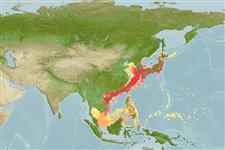| Native range | All suitable habitat | Point map | Year 2100 |

|
| This map was computer-generated and has not yet been reviewed. |
| Paralichthys olivaceus AquaMaps Data sources: GBIF OBIS |
Length at first maturity
Lm ?, range 40 - ? cm
Utilisations par l'homme
Pêcheries: hautement commercial; Aquaculture: commercial
Phylogenetic diversity index
(Ref. 82805)
PD50 = 0.5000 many relatives (e.g. carps) 0.5 - 2.0 few relatives (e.g. lungfishes)
Niveau trophique
(Ref. 69278)
3.7 ±0.62 se; Based on food items.
Résilience
(Ref. 69278)
Milieu, temps minimum de doublement de population : 1,4 à 4,4 années (tm=3; Fec= 3 million)